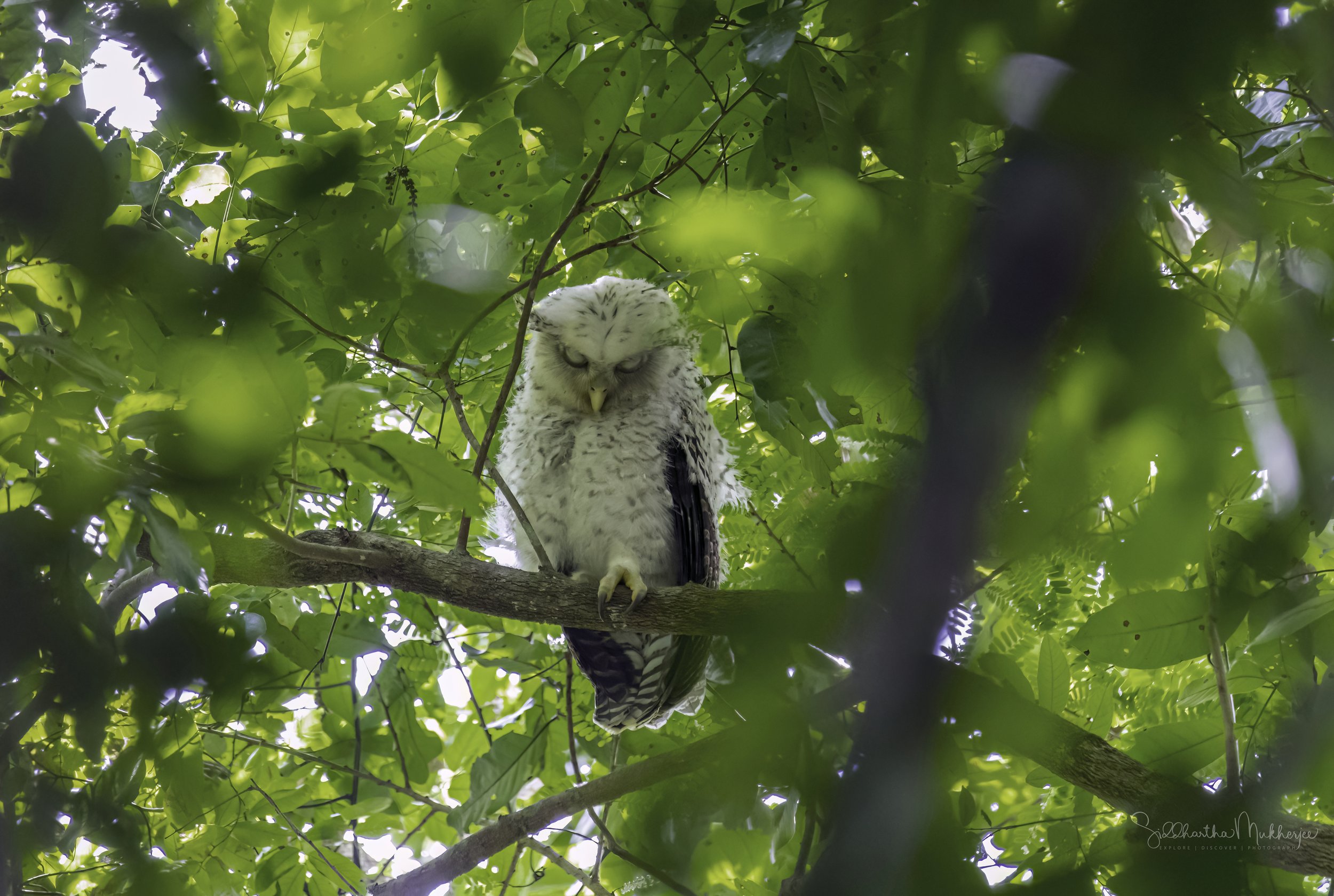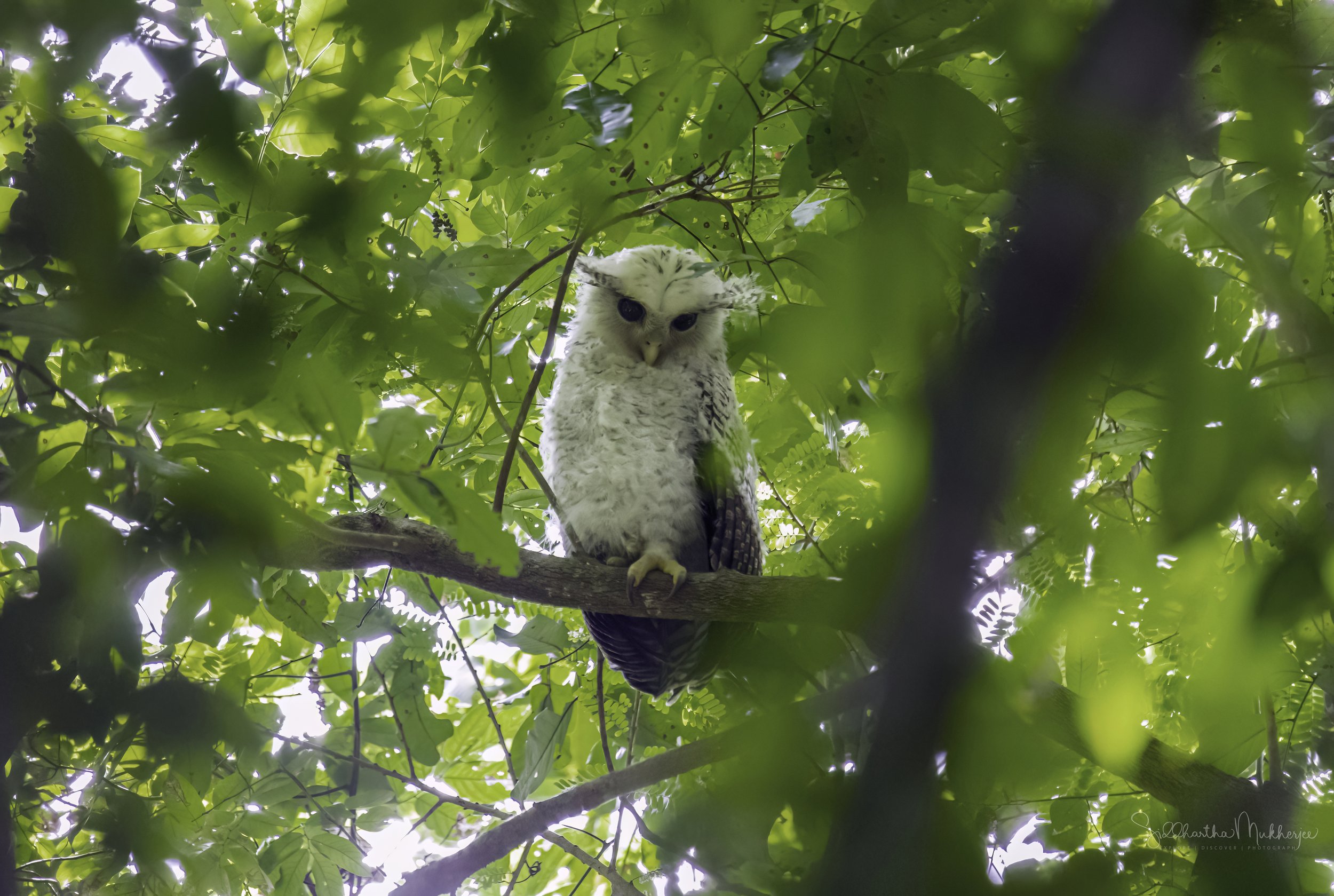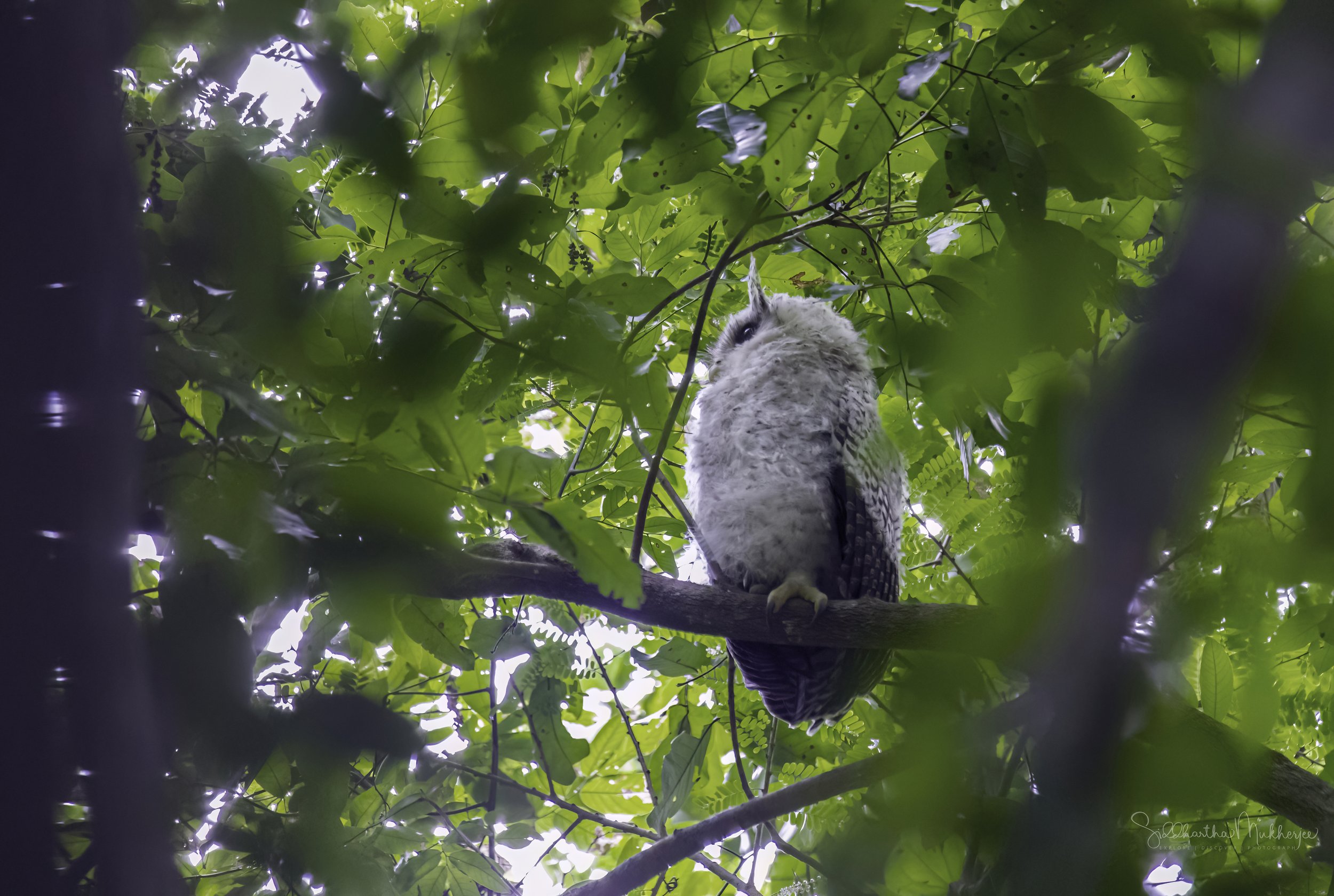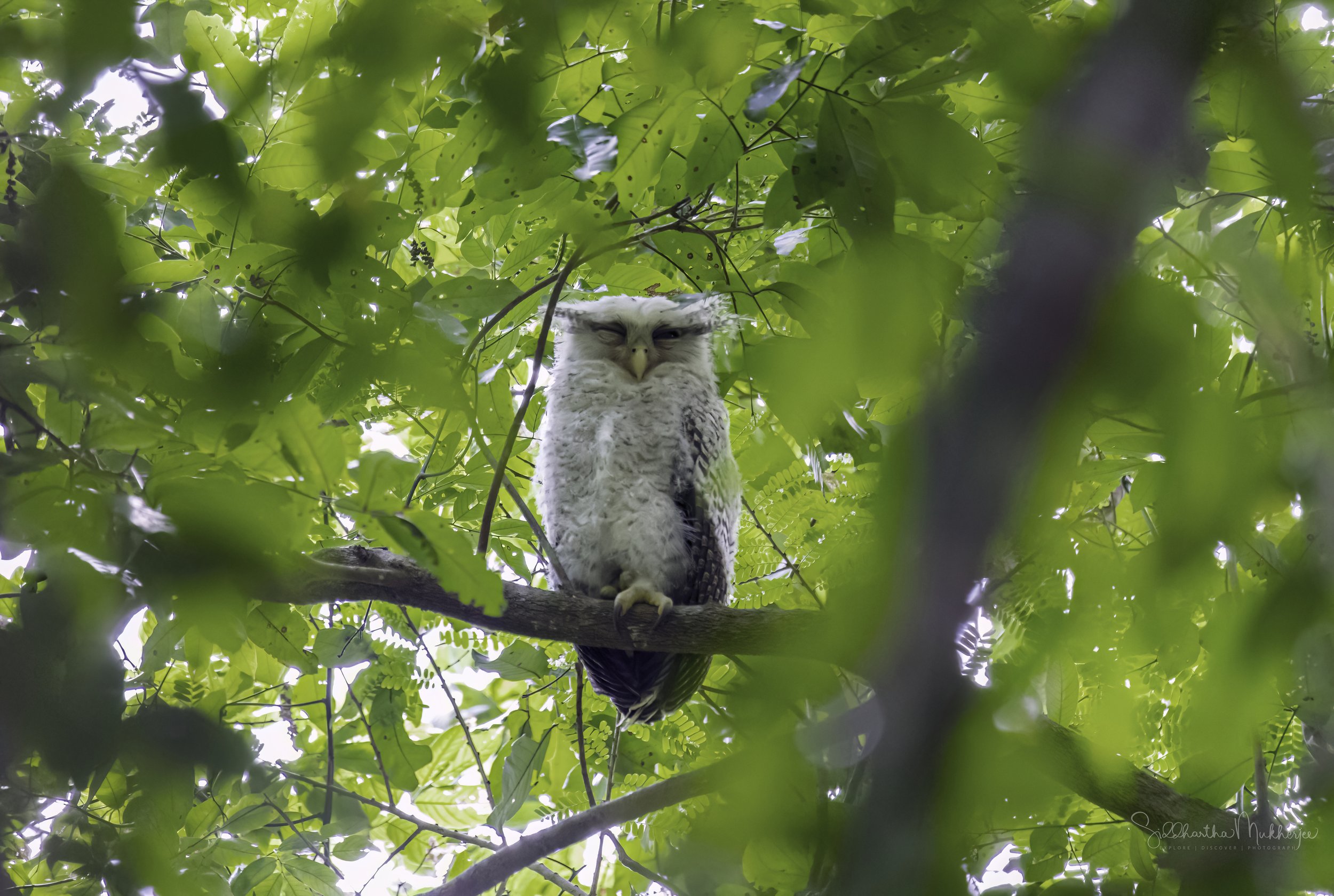Spot-bellied Eagle Owl
Ketupa nipalensis
Kaeng Krachan National Park, Thailand & Nallamala Forests, Telangana
While hiking up the Pran Buri river deep within the Kaeng Krachan National Park we heard the distinctive call of the Spot-bellied Eagle Owl. The Pran Buri River (Maenam Pran Buri, pronounced mɛ̂ːnáːm prāːn būrīː) is a river in the Prachuap Khiri Khan Province, Thailand, on the Kra Isthmus of the Malay Peninsula. The Pran Buri River originates in the southern part of the Kaeng Krachan National Park in the Tenasserim Hills and after 130 kilometres empties into the Gulf of Thailand.
At the time I saw the Spot-bellied Eagle Owl it was known as the Bubo nipalensis but there have been some considerable changes since then. The Bubo genus is now left with only six extant species: the European Eagle Owl (Bubo bubo), the West Asian Eagle Owl (Bubo turcomanus), the Central Asian Eagle Owl (Bubo hemachalanus), the Chinese Eagle Owl (Bubo kiautschensis), the Siberian Owl (Bubo sibiricus), and the Blakiston's Eagle Owl (Bubo blakistoni), which means many species are relocated to four distinct genera:
Nyctea with only one extant species being the Snowy Owl (Nyctea scandiaca),
Neobubo with two extant species being the Great Horned Owl (Neobubo virginianus) and the Lesser Horned Owl (Neobubo magellanicus),
Indobubo with six extant species being the Arabian Eagle Owl (Indobubo milesi), the Dusky Eagle Owl (Indobubo coromandus), the Forest Eagle Owl (Indobubo nipalensis), the Indian Eagle Owl (Indobubo bengalensis), the Barred Eagle Owl (Indobubo sumatranus), and the Philippine Eagle Owl (Indobubo philippensis), and
Afrobubo with nine extant species being the Pharaoh Eagle Owl (Afrobubo ascalaphus), the Spotted Eagle Owl (Afrobubo africanus), the Greyish Eagle Owl (Afrobubo cinerascens), the Giant Eagle Owl (Afrobubo lacteus), the Shelley's Eagle Owl (Afrobubo shelleyi), the Akun Eagle Owl (Afrobubo leucostictus), the Usambara Eagle Owl (Afrobubo vosseleri), the Fraser's Eagle Owl (Afrobubo poensis), and the Cape Eagle Owl (Afrobubo capensis).
While the genera Nyctea (the Snowy Owl Lineage) and Neobubo (New World Eagle Owls) are allied with each other, the genus Indobubo (South Asian Eagle Owls) is more closely related to the Fish Owls (genus Ketupa) and the genus Afrobubo (African Eagle Owls) is more closely related to the Fishing Owls (genus Scotopelia), whereas the genus Bubo (Palearctic Eagle Owls) is more distantly related from all the other groups.
All of this information is thanks to an exchange on my YouTube channel with a viewer - Indy Reno - who saw the Blakiston’s Eagle Owl and kindly suggested the change and provided all the detail. Thank you Indy Reno.
Owls are birds from the order Strigiformes, which includes over 200 species of mostly solitary and nocturnal birds of prey typified by an upright stance, a large, broad head, binocular vision, binaural hearing, sharp talons, and feathers adapted for silent flight. Exceptions include the diurnal northern hawk-owl and the gregarious burrowing owl. Owls hunt mostly small mammals, insects, and other birds, although a few species specialize in hunting fish. They are found in all regions of the Earth except polar ice caps and some remote islands. Owls are divided into two families: the true (or typical) owl family, Strigidae, and the barn-owl family, Tytonidae.
Read about the owls I have photographed.
Ketupa is a genus of owls in the family Strigidae. The genus formerly contained just three species, but based on the results from a genetic study published in 2020, the generic boundaries were altered. The genus now contains twelve species, nine of which were formerly placed in the genus Bubo. Ketupa nipalensis is one such species which was long treated in the genus Bubo, but it has been found that the genus Ketupa is embedded within the traditional Bubo, while Scotopelia either may be embedded with the Ketupa group of species, or perhaps is sister to this clade. Provisionally we recognize three genera: Bubo (Old and New World); Ketupa (tropical Afro-Asian, including some species formerly included in Bubo); and Scotopelia. Note that Ketupa is expanded to include eight species previously classified in Bubo; four of these (Ketupa poensis, Ketupa lacteus, Ketupa nipalensis, and Ketupa sumatranus) are confirmed by genetic data as belonging to the Ketupa clade, while the remaining four (Ketupa shelleyi, Ketupa coromandus, Ketupa leucostictus, and Ketupa philippensis) are inferred to belong to Ketupa based on morphological similarities to species of the first group.
Unlike the "fish owls" that were also considered to be included in Ketupa, the barred and the spot-bellied species are not closely tied to riparian habitats and piscivorous eating habits. However, all eagle-owls and fish owls (as well as the snowy owl (Bubo scandianus)) have been deemed insufficiently distinct to warrant separate genera and current authors generally treat all within the genus Bubo. Due to its forest-dwelling habits and some superficial characteristics, it has been wondered by some authors if the spot-bellied eagle-owl is related to the rainforest-dwelling eagle-owls of Africa, namely the Fraser's (Ketupa poensis) and similarly-sized Shelley's eagle-owl (Ketupa shelleyi).
Spot-bellied Eagle Owl - Juvenile
Nallamala Forest
I have also heard the spot-bellied eagle owl deep in the Nallamala forests of Telangana, my home state. Telangana is endowed with rich diversity of flora and fauna. It has dense teak forests on the northern part along the banks of river Godavari. As per the Champion & Seth Classification of Forest Types (1968), the forests in Telangana belong to three Forest Type groups, which are further divided into 12 Forest Types. The State Government has taken up a massive greening programme, 'Telangana Ku Harita Haram' in the State to plant and protect 230 crore seedlings over a period of 4 years. This initiative aims at achieving the twin objectives of increasing the forest cover and reduce pressure on the existing forest resources, through massive community participation by Vana Samrakshna Samithis (VSS) and Eco-Development Committees (EDCs) in Protected Areas and Watershed Development Committees in the Watershed areas. Recorded Forest Area (RFA) in the State is 26,904 km² of which 20,353 km² is Reserved Forest, 5,939 km² is Protected Forest and 612 km² is Unclassed Forests. In Telangana, during the period 1st January 2015 to 5th February 2019, a total of 9,420 hectares of forest land was diverted for non-forestry purposes under the Forest Conservation Act, 1980 (MoEF & CC, 2019). As per the information received from the State during that last two years, 12,730 ha of plantations including avenue plantations in the State.
Source: Mammalian and avian diversity of the Nallamala Hills, Andhra Pradesh by C. Srinivasulu & V. Nagulu, Wildlife Biology Section, Department of Zoology, Osmania University, Hyderabad, Andhra Pradesh 500007, India
Three National Parks and nine Wildlife Sanctuaries constitute the Protected Area network of the State covering 5.08% of its geographical area and our focus area today is the northern fringe of the Nallamalla forest located both in Telangana and Andhra Pradesh. Nallamala Forest is located in the Indian state of Andhra Pradesh and Telangana. It is part of the Eastern Ghats. Nagarjunsagar-Srisailam Tiger Reserve the largest tiger reserve in India and spread over the five districts of Nandyala, Prakasam, Guntur, Nalgonda and Mahbubnagar.
The once dense and secure forest of Nallamala is under severe threat due to habitat destruction, livestock pressure and biotic interference. Human greed has taken its toll and the after effects are reflected in the deserted look of the forest, especially across the Amrabad plateau. Rapid developmental activities are underway jeopardising biotic integrity and sustenance of floral & faunal components. The northern region of the Nallamala Hills, especially north of the Krishna River falling in the districts of Mahbubnagar and Nalgonda, has been greatly affected by anthropogenic and biotic pressure, while the central and southern regions are relatively better. Management intervention should ensure checking of illegal entry, livestock pressure, poaching, tree felling, etc. to ensure conservation priorities and sustenance of sylvan tribal population. This spectacular treasure-chest of nature will soon be empty without timely conservation measures.
Read about some of the birds of the Nallamala forests.
Kaeng Krachan National Park
Kaeng Krachan National Park is located in Phetchaburi and Prachuap Khiri Khan Provinces, about 60 km from Phetchaburi and 75 km from Hua Hin. It is bounded by the Tanintharyi Nature Reserve along Myanmar's border to the west and part of the Western Forest Complex that covers 18,730 km² across 19 protected sites between Myanmar and Thailand. There are two main rivers in the park; Phetchaburi and Pran Buri Rivers. Both rivers originate from the Tanaosri Mountain Range. In the north, Phetchaburi River flows into Kaeng Krachan Dam and flows further east all the way out to the Gulf of Thailand. Pran Buri River flows south to Prachuap Khiri Khan Province, into Pran Buri Reservoir and out to the Gulf of Thailand.
The highest elevation in the park is a peak along the Burmese border at around 1,500 meters. The park is popular for wildlife which doesn’t necessarily mean it is easy. The possibilities depend on the seasons and seasonal conditions for various types of animals. Mammals like leopards, clouded leopards, bears, stump-tailed macaques, sambhar, barking deer, elephants, dholes, golden jackal, gaur, serows, crab-eating mongoose and tapirs can be spotted in the park. There also used to be a significant tiger population in the park up until a decade ago, but only a few are left now.
Langurs, stump-tailed macaques, white-handed gibbons, sambhar, mouse deer, porcupines, monitor lizards, civets and black giant squirrel are frequently seen. White-handed gibbons can be seen or heard nearly every day, often seen at the edge of the campsites.
Read about the birds of the Kaeng Krachan National Park.
Spot-bellied Eagle Owl
The Spot-bellied Eagle Owl (Ketupa nipalensis), also known as the forest eagle-owl is an immense and imposing owl of dense wet lowland and hill forests. The silver-gray adult is majestic, with a large yellow bill, black eyes, and sweeping sidewards-facing “horns.” The juvenile, featured in this blog, is much paler, almost white, with shorter tufts. It is a large bird of prey with a formidable appearance inhabiting forests of the Indian Subcontinent and Southeast Asia which can echo with its deep echoing hoots. It is primarily nocturnal, but will on occasion hunt by day and has been known to take prey as large as small deer.
The spot-bellied eagle-owl, like its close relative, the barred eagle-owl, is one of the species that has moved into Ketupa according to mtDNA cytochrome b sequence data (Olsen et al. 2002). Unlike the "fish owls" that were also considered to be included in Ketupa, the barred and the spot-bellied species are not closely tied to riparian habitats and piscivorous eating habits.
The spot-bellied eagle-owl is a large species of owl measuring 50 to 65 cm in length. It is the sixth longest owl in the world on average and has the ninth longest wings of any living owl. The widely reported average weight range for the species is 1.5 to 2.5 kg.
The ear-tufts of the spot-bellied are very long and conspicuously of variable length, giving them a somewhat scraggly appearance at the tips. They measure 63 to 76 mm in length. It has feathered legs and feet, like most eagle-owls, but the terminal digits of the toes are bare before the talons. The feet and talons are as formidable as any eagle-owl, being very large, heavy and powerful for their size. This species typically measures 425 to 477 mm in wing chord length, 230 to 250 mm in tail length, 60 to 62 mm in tarsal length and 52 to 54 mm in culmen length. The subspecies of spot-bellied eagle-owl found on Sri Lanka, K. n. blighi, is linearly about 10% smaller than the birds found further north in India but about the same size as owls from the southern tip of India. K. n. blighi has a wing chord length of 370 to 455 mm, a tail length of 184 to 240 mm, a longer tarsus than northern birds at 63 to 68 mm and a culmen length of 43 to 48 mm. Other than size, the only feature that distinguishes northern birds from Sri Lankan birds is an ill-defined band of honey-brown colour on the pectorals.
The spot-bellied eagle-owl is overall a stark, grayish-brown bird, with dark, coarse brown coloration over the back and upper wings. The throat and underparts are mainly pale fulvous in color with black and white horizontal stripes along the flanks of the body that become broad spots on the abdomen and undertail coverts. On the wings, the primaries are dark brown with lighter brown stripes and the secondaries are more heavily barred with buff-brown coloration. The lores are covered in bristly feathers and the cheeks are brownish-white with black feather shafts. The large ear-tufts slant off to the sides. Juveniles birds are distinct from adult birds, being a much paler grayish-cream overall with fairly heavy brownish barring. Distinguishing the spot-bellied eagle-owl is relatively straightforward, since other Indian and southeast Asian eagle owls do not generally dwell in deep forests as does this species. The spot-bellied is the largest of the owls in its range other than the tawny fish owl (Ketupa flavipes), which is restricted in both habitat and diet to mountain streams. The brown fish owl (Ketupa zeylonensis), which is quite different in colouring if seen reasonably well, is slightly smaller linearly than the spot-bellied eagle-owl and is found in more wetland-based (and often somewhat more degraded) habitats. The subspecies of Eurasian eagle-owl (Bubo bubo hemachalana) found in the Himalayas may inhabit higher elevations of the same mountains where the spot-bellied eagle-owl dwells in the lower elevations in the forested foothills but there their ranges barely abut. The Indian eagle-owl (Bubo bengalensis) (typically found in wooded vicinities of rocky areas) is around 10% smaller than the spot-bellied; the dusky eagle-owl (Ketupa coromanda) (typically found in woods near wetlands) is around 15% smaller; and the brown wood owl, the largest Strix widely found in the Indian subcontinent and Southeast Asia, is around 35% smaller. Furthermore, the colouring and markings of the spot-bellied eagle-owl are distinctive from all but the barred eagle-owl, which it does not co-exist with in the wild. The barred and spot-bellied eagle-owls are immediately distinguished in the field from other eagle-owls by their pale-looking, sideways slanting ear-tufts, and the degree of feathering on the legs and feet. This species pair unlike sympatric eagle-owls has horizontal rather than vertical underside markings (which coalesce somewhat in the barred eagle-owl to barring, but appear as almost continuous spotting on the spot-bellied eagle-owl) over a much paler ground colour, while the back is slightly grayer looking, lacking any warmer brown or tawny tones.
This owl is noted for its strange, human-sounding call consisting of a scream, which rises and then falls in tone. The territorial call of the species consists of low hoots with two-second intervals between hoots. The voice is booming, deep and carries quite far. It is usual for forest-dwelling owls (and many different kinds of birds) to have an extensive and complex range of vocalisations since vision is more limited than in open or semi-open habitats. However, the spot-bellied eagle-owl has relatively small ear openings, even for a member of the genus Bubo, suggesting that some territorial behaviour is carried out visually instead of though sound.
This species is distributed through the Lower Himalayas from Kumaon east to Burma, thence to central Laos and central Vietnam. They are found throughout the Indian subcontinent and peninsular Southeast Asia, reaching the southernmost limits of their range in Sri Lanka and 12 degrees north in southern Thailand. The spot-bellied eagle-owl dwells mainly in primary or older second growth forests. Potentially, they can come to inhabit nearly all varieties of land-based habitats but prefer those such as dense, evergreen forests or moist deciduous forests within their range, though they do extend into tropical valleys, terrai and shola in the lower hills of India. Although often considered uncommon to somewhat rare, recent photographic evidence indicates that they are widely found in different parts of India and may simply avoid detection, so long as appropriate wooded habitat remains. They are found in a range of climates from the temperate woodlands of Nepal to the humid, tropical rainforest of Southeast Asia. However. the spot-bellied eagle-owl is mainly a species of tropical and subtropical foothills, mostly distributed at elevations of 900–1,200 m, but it can be found from sea-level to 6,300 m, the latter in the Transhimalayas.
The spot-bellied eagle-owl is nocturnal and often spends its day hidden in the dense foliage of large forest trees. However, they have been observed on the move and even hunting during the day, especially in forests with minimal human disturbance. Their activity normally picks up at dusk as they begin to hunt. In larger forest owls, a partially diurnal behaviour is not uncommon. The bright whitish colouration, overlaid with brownish cross-bars, forming a brow over the eyes to the front of the ear-tufts is theorised to play a primary role in expression of behavioural intent.
The spot-bellied eagle owl is generally uncommon, likely needing large hunting and breeding territories and thus occurs at low densities. However, it continues to occur over a large range and is not thought to be conservation dependent. Areas where deforestation occurs are likely to be vacated by this species, which is perhaps the only widespread threat faced by this owl. Despite its unknown and probably declining population size, the spot-bellied eagle-owl is evaluated as least concern on the IUCN Red List.
‡‡‡‡‡
Related Posts




























